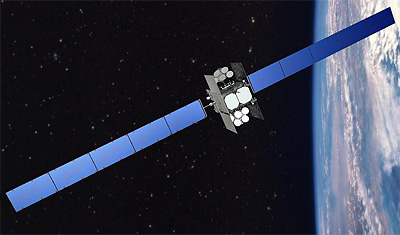WGS 4, 5, 6, 7 (WGS Block 2) (original) (raw)

WGS 4 [Boeing BSS]
In early 2001, a satellite communications industry team led by Boeing Satellite Systems was selected to develop the Wideband Gapfiller Satellite (WGS) system as successors to the DSCS-3 series of communications satellites. This high-capacity satellite communications system is intended to support the warfighter with newer and far greater capabilities than provided by current systems. In March 2007 the acronym WGS was changed to Wideband Global Satcom.
A joint-service program funded by the U.S. Air Force and Army, WGS includes options for up to six BSS-702 satellites and their associated spacecraft and payload control equipment. Operational and logistics support and training are also included in the program.
WGS will augment DoD communications services currently provided by the Defense Satellite Communications System (DSCS), which provides Super High Frequency (SHF) wideband communications, and by the Ka-band Global Broadcast Service (GBS), which uses direct broadcast satellite technology to provide critical information to U.S. and allied forces. With an initial launch scheduled for mid-2004 aboard an Air Force Evolved Expendable Launch Vehicle, WGS will provide early transformational capabilities supporting government objectives for a Transformational Communications Architecture in 2009 and beyond.
WGS combines unique commercial spacecraft capabilities that Boeing has developed, including phased array antennas and digital signal processing technology, into a powerful, flexible architecture. Based on the Boeing BSS-702 bus, the satellite will have a dry mass of more than 3,000 kg and will produce more than 11 kilowatts of power at the end of its 14-year design life. The system provides tremendous operational flexibility and delivers the needed capacity, coverage, connectivity and control in support of demanding operational scenarios.
Capacity: WGS will offer 4.875 GHz of instantaneous switchable bandwidth. The system will provide capacity ranging from 2.1 Gbps to more than 3.6 Gbps to tactical users, depending on the mix of ground terminals, data rates and modulation schemes employed. Thus, each WGS can supply more than 10 times the capacity of a DSCS-3 Service Life Enhancement Program (SLEP) satellite.
Coverage: The WGS design includes 19 independent coverage areas that can be used throughout the field of view of each satellite to serve warfighters between 65� North and South latitude. This includes eight steerable/shapeable X-band beams formed by separate transmit and receive phased arrays; 10 steerable Ka-band beams served by independently steerable, diplexed gimbaled dish antennas, including three with selectable polarization; and one X-band Earth coverage beam.
Connectivity: The enhanced connectivity capabilities of WGS enable any user talk to any other user with very efficient use of satellite bandwidth. A digital channelizer divides the uplink bandwidth into nearly 1900 independently routable 2.6 MHz subchannels providing any-coverage-to-any-coverage connectivity (including X-to-Ka and Ka-to × crossbanding) for maximum operational flexibility. In addition, the channelizer supports multicast and broadcast services and provides an extremely effective and flexible uplink spectrum monitoring capability for network control.
The Block II satellites are similar to the three Block I satellites already in production. Under Block II, Boeing added a radio frequency bypass capability designed to support airborne intelligence, surveillance and reconnaissance platforms requiring ultra-high bandwidth and data rates demanded by unmanned aerial vehicles. The Block II contract calls for the launch of F4 by the first quarter of 2011 and subsequent launches every year thereafter.
In January 2002, the customer exercised options worth $336.4 million authorizing Boeing to build the first two WGS spacecraft and to procure long-lead material for a third satellite. The first satellite was scheduled to launch in early 2004, with the second one to follow in 2005, both aboard a U.S. Air Force Evolved Expendable Launch Vehicle. The program has been delayed to a first launch in 2007.
Boeing and the U.S. Air Force MILSATCOM Systems Wing have signed in October 2006 a $1.067 billion contract for up to three more Wideband Gapfiller Satellites (WGS), if all options are exercised. The Option for WGS 4 and 5 was exercised in November 2006. WGS 6 was ordered in 2007 by Australia, which will get access to the WGS system in return. The order for long lead items for WGS 7 was placed in August 2010. The final contract for this satellite was awarded in September 2011, together with long lead items for WGS 8 and an option for WGS 9. WGS 8 was awarded in December 2011. WGS 10 was ordered in July 2012.
Boeing received in July 2012 an contract to install upgraded digital channelizers, which will boost capacity on the satellites by 30 percent, aboard the eighth and ninth WGS satellites. The upgraded hardware also will be installed on the planned 10th WGS satellite. These satellites are called WGS Block-2 Follow-On.